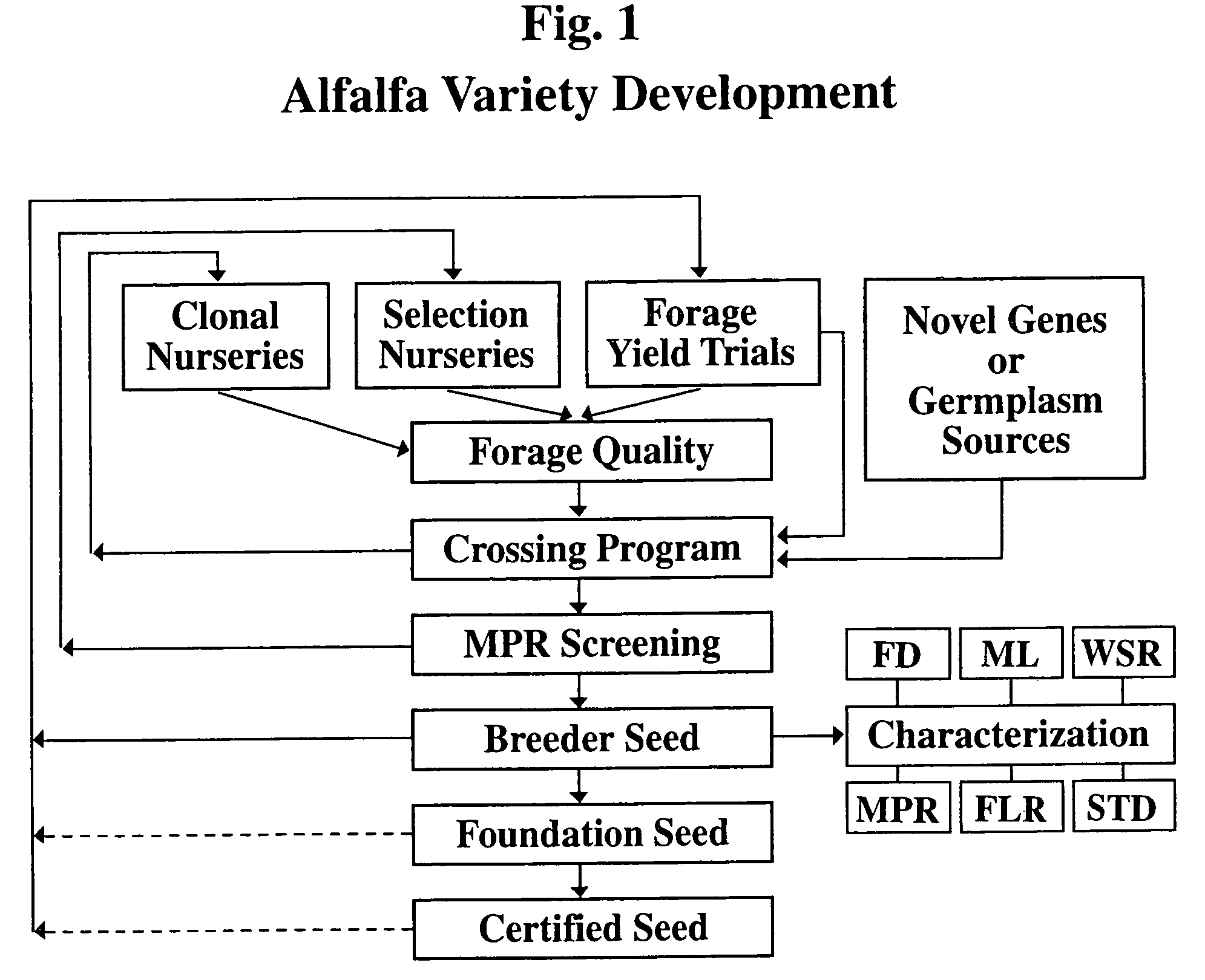Alfalfa plants having improved fast recovery after harvest and methods for producing same
a technology of alfalfa plants and fast recovery, applied in the field of alfalfa plants, can solve the problems of limiting the overall alfalfa yield, reducing the yield and quality of harvested crops, and plant stubble being left in the field at harvest time, etc., to achieve fast recovery, high yield, and persistence.
- Summary
- Abstract
- Description
- Claims
- Application Information
AI Technical Summary
Benefits of technology
Problems solved by technology
Method used
Image
Examples
example 1
Alfalfa Varieties with Fast Recovery After Spring Green-up or After Harvest
[0089]Recovery after spring green-up or after harvest refers to the rate of regrowth after spring green-up or after harvest. This is determined by measuring plant height at varying intervals and then comparing growth with check varieties. In particular, after approximately 3-7 days the average height, to the nearest centimeter, of the plant canopy was measured. The measurement was repeated every few days through 21 days after the last cutting date.
[0090]The average height measurement was then converted to growth rate (cm / day) by dividing plant canopy height (cm) by the number of days since the last cutting. The average growth rate (cm / day) was then converted to a % of a comparison variety by dividing test variety growth rate by the comparison variety growth rate (cm / day) and then multiplying by 100.
[0091]
TABLE 1The recovery of alfalfa varieties ‘CW 75046’, ‘CW 83201’,and ‘CW 85029’ as compared to check variet...
example 2
Alfalfa Varieties with Improved Standability
[0098]The following tables provide data demonstrating the improved standability of alfalfa varieties adapted to growing and production in North America. See the Definitions section, above, for the scale used in determining the Standability Ratings. Statistics (e.g., Grand Mean, LSD, C.V., R2) are based on the data collected for an entire trial.
[0099]
TABLE 7aThe standability of alfalfa varieties ‘CW 95026’, ‘CW 75046’,‘CW 83201’, and ‘CW 85029’ as compared to commercially availablecheck varieties all grown at the same time in the same location.A01WIWS - Spring Forage Yield Trial at West Salem, WI.Date Last Cut / May 21June 24August 28All CuttingsSpring Greenup# days growing343047Ave. = 37Date RatedJune 24July 24October 14EntryStandability RatingsCW 050088.008.008.258.08CW 040077.507.508.507.83CW 950268.507.006.507.33CW 750467.506.506.506.83WinterGold5.006.004.755.25CW 830217.503.503.504.83CW 850297.004.503.004.83WL 3425.504.004.504.67Amerista...
example 3
Development of New Alfalfa Varieties
Alfalfa Variety ‘CW 75046’
[0106]‘CW 75046’ is a high yielding, persistent variety with improved standability and fast recovery after spring green-up or after harvest with no observed soil type or management limitations. ‘CW 75046’ is a synthetic variety with 225 parent plants that were selected for resistance to Phytophthora root rot. Parent plants were selected from crosses between selections from two year old Wisconsin nurseries for winter survival, leaf disease resistance, healthy green color, fast recovery after spring green-up or after harvest, and high standability; and from crosses between the nursery selections and selections from three year old Wisconsin and Minnesota yield trials for moderate to late fall dormancy, good agronomic appearance, fast recovery, high leaf to stem ratio, and resistance to crown rot, Bacterial wilt, Fusarium wilt, and Verticillium wilt.
[0107]Alfalfa variety ‘CW 75046’ was developed by the following method:
[0108]...
PUM
| Property | Measurement | Unit |
|---|---|---|
| angle | aaaaa | aaaaa |
| angle | aaaaa | aaaaa |
| angle | aaaaa | aaaaa |
Abstract
Description
Claims
Application Information
 Login to View More
Login to View More - R&D
- Intellectual Property
- Life Sciences
- Materials
- Tech Scout
- Unparalleled Data Quality
- Higher Quality Content
- 60% Fewer Hallucinations
Browse by: Latest US Patents, China's latest patents, Technical Efficacy Thesaurus, Application Domain, Technology Topic, Popular Technical Reports.
© 2025 PatSnap. All rights reserved.Legal|Privacy policy|Modern Slavery Act Transparency Statement|Sitemap|About US| Contact US: help@patsnap.com

